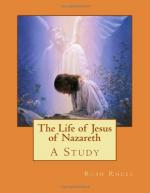6. In Samaria and Judea soldiers were under the command of the procurator; they took orders from the tetrarch, in Galilee and Perea. The garrison of Jerusalem consisted of one Roman cohort—from five to six hundred men—which was reinforced at the time of the principal feasts. These and the other forces at the disposal of the procurator were probably recruited from the country itself, largely from among the Samaritans. The centurion of Capernaum (Matt. viii. 5; Luke vii. 2-5) was an officer in the army of Antipas, who, however, doubtless organized his army on the Roman pattern, with officers who had had their training with the imperial forces.
7. The administration of justice in Samaria and Judea was theoretically in the hands of the procurator; practically, however, it was left with the Jewish courts, either the local councils or the great sanhedrin at Jerusalem. This last body consisted of seventy-one “elders.” Its president was the high-priest, and its members were drawn in large degree from the most prominent representatives of the priestly aristocracy. The scribes, however, had a controlling influence because of the reverence in which the multitude held them. The sanhedrin of Jerusalem had jurisdiction only within the province of Judea, where it tried all kinds of offences; its judgment was final, except in capital cases, when it had to yield to the procurator, who alone could sentence to death. It had great influence also in Galilee, and among Jews everywhere, but this was due to the regard all Jews had for the holy city. It was, in fact, a sort of Jewish senate, which took cognizance of everything that seemed to affect the Jewish interests. In Galilee and Perea, Antipas held in his hands the judicial as well as the military and financial administration.
8. To the majority of the priests religion had become chiefly a form. They represented the worldly party among the Jews. Since the days of the priest-princes who ruled in Jerusalem after the return from the exile, they had constituted the Jewish aristocracy, and held most of the wealth of the people. It was to their interest to maintain the ritual and the traditional customs, and they were proud of their Jewish heritage; of genuine interest in religion, however, they had little. This secular priestly party was called the Sadducees, probably from Zadok, the high-priest in Solomon’s time. What theology the Sadducees had was for the most part reactionary and negative. They were opposed to the more earnest spirit and new thought of the scribes, and naturally produced some champions who argued for their theological position; but the mass of them cared for other things.




